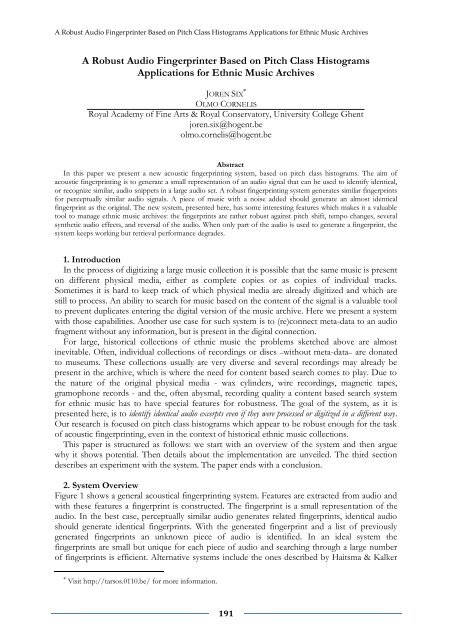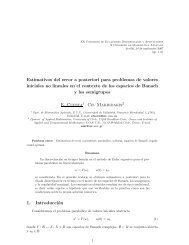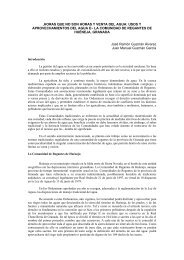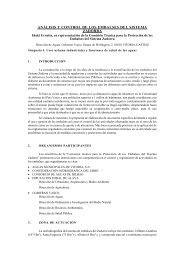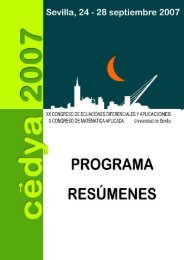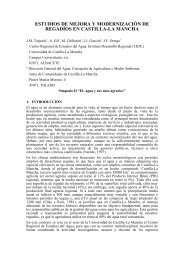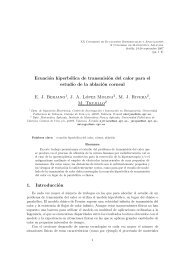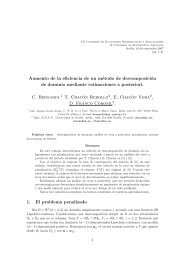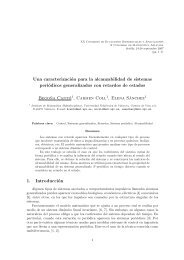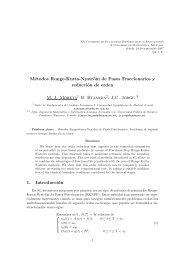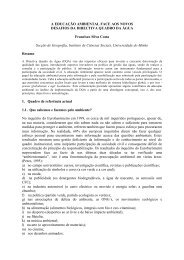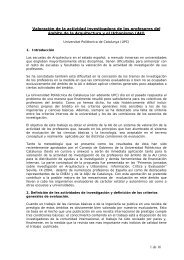LIBRO DE ACTAS (pdf) - Universidad de Sevilla
LIBRO DE ACTAS (pdf) - Universidad de Sevilla
LIBRO DE ACTAS (pdf) - Universidad de Sevilla
You also want an ePaper? Increase the reach of your titles
YUMPU automatically turns print PDFs into web optimized ePapers that Google loves.
A Robust Audio Fingerprinter Based on Pitch Class Histograms Applications for Ethnic Music Archives<br />
A Robust Audio Fingerprinter Based on Pitch Class Histograms<br />
Applications for Ethnic Music Archives<br />
JOREN SIX <br />
OLMO CORNELIS<br />
Royal Aca<strong>de</strong>my of Fine Arts & Royal Conservatory, University College Ghent<br />
joren.six@hogent.be<br />
olmo.cornelis@hogent.be<br />
Abstract<br />
In this paper we present a new acoustic fingerprinting system, based on pitch class histograms. The aim of<br />
acoustic fingerprinting is to generate a small representation of an audio signal that can be used to i<strong>de</strong>ntify i<strong>de</strong>ntical,<br />
or recognize similar, audio snippets in a large audio set. A robust fingerprinting system generates similar fingerprints<br />
for perceptually similar audio signals. A piece of music with a noise ad<strong>de</strong>d should generate an almost i<strong>de</strong>ntical<br />
fingerprint as the original. The new system, presented here, has some interesting features which makes it a valuable<br />
tool to manage ethnic music archives: the fingerprints are rather robust against pitch shift, tempo changes, several<br />
synthetic audio effects, and reversal of the audio. When only part of the audio is used to generate a fingerprint, the<br />
system keeps working but retrieval performance <strong>de</strong>gra<strong>de</strong>s.<br />
1. Introduction<br />
In the process of digitizing a large music collection it is possible that the same music is present<br />
on different physical media, either as complete copies or as copies of individual tracks.<br />
Sometimes it is hard to keep track of which physical media are already digitized and which are<br />
still to process. An ability to search for music based on the content of the signal is a valuable tool<br />
to prevent duplicates entering the digital version of the music archive. Here we present a system<br />
with those capabilities. Another use case for such system is to (re)connect meta-data to an audio<br />
fragment without any information, but is present in the digital connection.<br />
For large, historical collections of ethnic music the problems sketched above are almost<br />
inevitable. Often, individual collections of recordings or discs –without meta-data– are donated<br />
to museums. These collections usually are very diverse and several recordings may already be<br />
present in the archive, which is where the need for content based search comes to play. Due to<br />
the nature of the original physical media - wax cylin<strong>de</strong>rs, wire recordings, magnetic tapes,<br />
gramophone records - and the, often abysmal, recording quality a content based search system<br />
for ethnic music has to have special features for robustness. The goal of the system, as it is<br />
presented here, is to i<strong>de</strong>ntify i<strong>de</strong>ntical audio excerpts even if they were processed or digitized in a different way.<br />
Our research is focused on pitch class histograms which appear to be robust enough for the task<br />
of acoustic fingerprinting, even in the context of historical ethnic music collections.<br />
This paper is structured as follows: we start with an overview of the system and then argue<br />
why it shows potential. Then <strong>de</strong>tails about the implementation are unveiled. The third section<br />
<strong>de</strong>scribes an experiment with the system. The paper ends with a conclusion.<br />
2. System Overview<br />
Figure 1 shows a general acoustical fingerprinting system. Features are extracted from audio and<br />
with these features a fingerprint is constructed. The fingerprint is a small representation of the<br />
audio. In the best case, perceptually similar audio generates related fingerprints, i<strong>de</strong>ntical audio<br />
should generate i<strong>de</strong>ntical fingerprints. With the generated fingerprint and a list of previously<br />
generated fingerprints an unknown piece of audio is i<strong>de</strong>ntified. In an i<strong>de</strong>al system the<br />
fingerprints are small but unique for each piece of audio and searching through a large number<br />
of fingerprints is efficient. Alternative systems inclu<strong>de</strong> the ones <strong>de</strong>scribed by Haitsma & Kalker<br />
Visit http://tarsos.0110.be/ for more information.<br />
191


